Southampton
Explore hidden histories, historic photos, and things you never knew about Southampton from the collections and archives of Historic England.
Discover your local listed buildings and places
Introducing some of Southampton's most historic sites, included in the National Heritage List for England. Some of these captions have been summarised by AI. Click through for the official List entry. Skip this section and go to place by numbers
Bar Gate and Guildhall
Southampton
The Bar Gate and Guildhall, dating from circa 1180 with 13th-century additions, features historic architecture including drum towers, arrow slit windows, and a statue of George III in Roman...
Gates No. 8 and No. 10 to the Western Docks
Southampton
Monumental gateways to the Western Docks. 1933-4 by the Southern Railway Company. Read the official list entry to find out more.
Puy de Dôme Sculpture, University of Southampton
Southampton
Public sculpture, 'Puy de Dôme', 1962 to 1963 by F E McWilliam, situated in a rectangular pool designed by Basil Spence and Partners for the sculpture adjacent to the Nuffield Theatre on the...
Central Parks
Southampton
Laid out between the late 1850s and early 1860s, the Southampton Central Parks: West Park, East Park, Palmerston Park, Houndwell, and Hoglands, provide a chain of public open space through...
Roman Catholic Church of St Boniface, including the bound…
Southampton
Roman Catholic church, opened in 1927, designed by WC Mangan, including boundary wall and railings. Read the official list entry to find out more.
Southampton Cenotaph
Southampton
First World War memorial by Sir Edwin Landseer Lutyens, 1920, with later inscriptions and additions. Read the official list entry to find out more.
Woolston Signal Box
Southampton
Signal box of London & South Western Railway Type 4 design, situated on the 'down' platform to the east of the listed Woolston Station booking hall.
Medieval Merchant's House
Southampton
The Medieval Merchant's House is a late 13th or early 14th-century stone building featuring a vaulted undercroft and a galleried interior with merchant marks.
Southampton Cemetery
Southampton
Following a visit to the seriously overcrowded St Mary's Churchyard by the Public Health Commissioners, in 1843 a Private Bill was introduced giving Southampton Corporation the power to use...
The Wool House
Southampton
The Wool House, built around 1338 by Cistercian Monks, is the sole surviving medieval warehouse in Southampton, used for wool export and later to house French prisoners.
Lansdowne House, including the cellar which forms part of…
Southampton
A late-C18 former townhouse, converted to an office and residence in the early C19, later used principally as office and converted back to residential use after the 1990s.
Water Gate Tower, Town Quay
Southampton
Water Gate Tower at Town Quay is a medieval structure with C14 and C15 origins, featuring a drum tower and notable architectural elements.
Former St Mary's drill hall
Southampton
Drill hall, built in 1889 by the architect W H Mitchell for the 1st Hampshire Artillery Volunteers. A rifle range was added in 1905.
Allen Memorial in Southampton Cemetery
Southampton
Neo-classical mausoleum dating to about 1900 built of Portland stone ashlar blocks. Read the official list entry to find out more.
North Western Gate Piers to Southampton Cemetery
Southampton
Gate piers, mid-C19. Read the official list entry to find out more.
Eastern Gate Piers to Southampton Cemetery
Southampton
Gate piers, c.1880. Read the official list entry to find out more.
Section of Wall Running North From God's House Along Back…
Southampton
This section of Southampton's medieval city walls includes a 13th-century half drum tower and is scheduled as an ancient monument.
Church of St Julian
Southampton
The Church of St Julian, established circa 1190, was a chapel for an almshouse. It later became known as the French Church, used by French Protestants from the 16th century.
Explore more
Search for more listed placesSouthampton through time
This timeline shows the first period of use for buildings and places on the National Heritage List for England, just one of the details recorded for every list entry. Click around to see how Southampton changes over time. Skip this section and go to aerial photos
Roman AD 43 to AD 410
Britain was invaded by four legions of the Roman army in AD 43, who relatively rapidly conquered England from landing points in Kent. Parts of Wales and Scotland soon followed.
Roman culture brought urbanism, monumental buildings, wide-ranging religious beliefs, writing, and strong social hierarchy. The Roman administrative system was withdrawn in AD 410.
Early medieval AD 410 to AD 1066
This period, often associated in England with Anglo-Saxons and Vikings, saw a reduction in urban living from the Roman period and increased migration from northern Europe.
Traces of this period can be found in cemeteries, particularly in artefacts and in some of the very early churches, as this period also saw the growth of Christianity in Britain.
Medieval AD 1066 to AD 1540
This period, sometimes known as the Middle Ages, began with the Norman invasion in AD 1066. It saw a significant rise in military and defensive buildings such as castles and earthworks, as well as religious houses dominating a largely agricultural landscape.
The monarchy and Church dominated the period, which also saw the break with the Roman Catholic Church and the English reformation.
Post medieval AD 1540 to AD 1901
The Post-Medieval period brought seismic changes to life in England, with religious reformation leading to the democratization of worship and the destruction of hundreds of religious houses.
In parallel, there was a huge expansion of scientific study and enlightenment that permanently altered the nation's social structure and landscape. Industrialization and mass production lead to wider global trade, emigration, and immigration.
20th century AD 1901 to AD 2000
The 20th century saw an incredible expansion of England's transport networks, with suburban growth shadowing rapid infrastructural expansion. The establishment of state schools, hospitals, and modern technical colleges, with new architectural styles, radically changed the appearance of towns and cities.
Two catastrophic world wars and the 1918 pandemic also brought unprecedented change, altering England's built environment and social structures forever.
Roman AD 43 to AD 410
Britain was invaded by four legions of the Roman army in AD 43, who relatively rapidly conquered England from landing points in Kent. Parts of Wales and Scotland soon followed.
Roman culture brought urbanism, monumental buildings, wide-ranging religious beliefs, writing, and strong social hierarchy. The Roman administrative system was withdrawn in AD 410.
Early medieval AD 410 to AD 1066
This period, often associated in England with Anglo-Saxons and Vikings, saw a reduction in urban living from the Roman period and increased migration from northern Europe.
Traces of this period can be found in cemeteries, particularly in artefacts and in some of the very early churches, as this period also saw the growth of Christianity in Britain.
Medieval AD 1066 to AD 1540
This period, sometimes known as the Middle Ages, began with the Norman invasion in AD 1066. It saw a significant rise in military and defensive buildings such as castles and earthworks, as well as religious houses dominating a largely agricultural landscape.
The monarchy and Church dominated the period, which also saw the break with the Roman Catholic Church and the English reformation.
Post medieval AD 1540 to AD 1901
The Post-Medieval period brought seismic changes to life in England, with religious reformation leading to the democratization of worship and the destruction of hundreds of religious houses.
In parallel, there was a huge expansion of scientific study and enlightenment that permanently altered the nation's social structure and landscape. Industrialization and mass production lead to wider global trade, emigration, and immigration.
20th century AD 1901 to AD 2000
The 20th century saw an incredible expansion of England's transport networks, with suburban growth shadowing rapid infrastructural expansion. The establishment of state schools, hospitals, and modern technical colleges, with new architectural styles, radically changed the appearance of towns and cities.
Two catastrophic world wars and the 1918 pandemic also brought unprecedented change, altering England's built environment and social structures forever.
Aerial photos of Southampton
Aerial photography helps reveal secrets of England's changing landscapes that are impossible to see from the ground. Skip this section and go to archive images

Southampton
RMS Majestic entering the King George V Graving Dock, Southampton, 1934
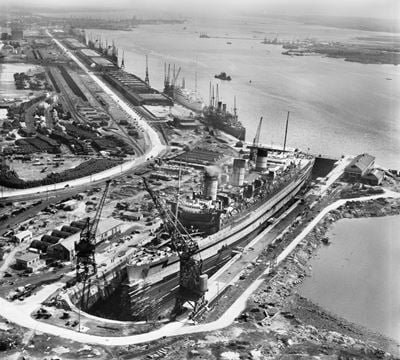
Southampton
Queen Mary in dry dock, Southampton, 1947

Southampton
East Park and Above Bar Street, Southampton, 1928
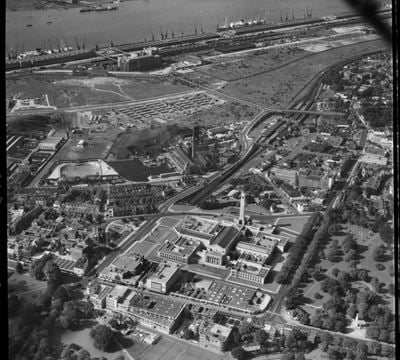
Southampton
The Civic Centre and environs, Southampton, 1957
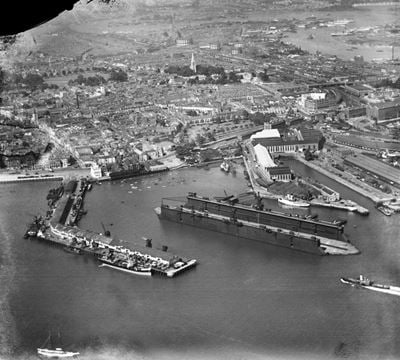
Southampton
The Floating Dock, the Town Quay and Trafalgar Dry Dock, Southampton, 1930

Southampton
Southampton Docks, Southampton, 1968
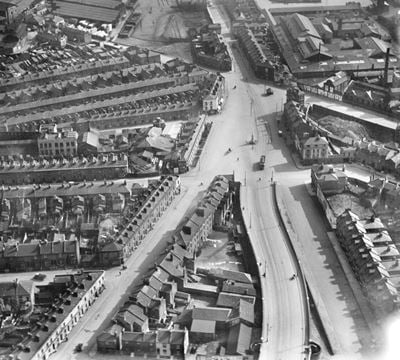
Southampton
Central Bridge Tramway, Southampton, 1928

Southampton
Princess Alexandra Dock, Southampton, 1974
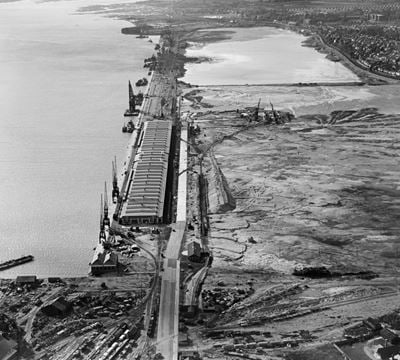
Southampton
Reclamation of the Western Docks between Royal Pier and Millbrook, Southampton, 1933

Southampton
An unidentified Ocean Liner docked alongside No 101 Passenger & Goods Shed, Southampton, 1953
Southampton in the Historic England Archive
The Historic England Archive cares for over 15 million images, dating from the 1850s to the present day. Discover stunning images of Southampton's past. Skip this section and go to stories about heritage
John Laing Collection
Woolston, City Of Southampton
Date created: 21 Jun 1978
A twin hull barge being launched from Woolston, for use in the construction of an outfall at Browndown for the Peel Common Sewage Works
London, Midland and Scottish Railway Company
City Of Southampton
Date created: Jul 1906
A view of the medieval West Gate, with boats on the shore visible through the archway
Nigel Temple Collection of Postcards of Parks and Gardens
City Of Southampton
Date created: 1925 - 1940
GENERAL VIEW SHOWING WESTERN PARADE AND PILGRIM FATHERS MEMORIAL
John Laing Collection
Woolston, City Of Southampton
Date created: 21 Jun 1978
A twin hull barge being towed down river from Woolston, for use in the construction of an outfall at Browndown for the Peel Common Sewage Works
London, Midland and Scottish Railway Company
Southampton, City Of Southampton
Date created: Jul 1906
A view looking west along Blue Anchor Lane towards the Blue Anchor Postern Gate with the northern wall of King John's Palace to the left
Nigel Temple Collection of Postcards of Parks and Gardens
Southampton, City Of Southampton, City Of Southampton
Date created: 1940 - 1960
VIEW SHOWING FOUNTAIN
John Laing Collection
Woolston, City Of Southampton
Date created: 21 Jun 1978
A twin hull barge being launched from Woolston, for use in the construction of an outfall at Browndown for the Peel Common Sewage Works
London, Midland and Scottish Railway Company
Southampton, City Of Southampton
Date created: Jul 1906
A view looking north across the east front of the Tudor House on Bugle Street
Nigel Temple Collection of Postcards of Parks and Gardens
Southampton, City Of Southampton, City Of Southampton
Date created: 1940 - 1960
VIEW LOOKING TOWARDS THE FOUNTAIN, ROSE GARDENS AND GRAND THEATRE
John Laing Collection
City Of Southampton
Date created: 23 May 1989
The north eastern entrance, on Portland Terrace, to the Gateway supermarket in Southampton, showing the tall glazed roof lantern that sits above
London, Midland and Scottish Railway Company
Southampton, City Of Southampton
Date created: Jul 1906
The east elevation of the Tudor House on Bugle Street
Nigel Temple Collection of Postcards of Parks and Gardens
City Of Southampton
Date created: 1900 - 1930
GENERAL VIEW
Stories about heritage in your local area
Historic England publishes news, blogs, research, videos, and podcasts celebrating England's rich heritage. Discover the stories we have about Southampton. Skip this section and go to education
10 Exceptional First World War Memorials
Mentions Southampton Cenotaph
These are some of the most outstanding memorials to those who died during the First World War.
Rooswijk Shipwreck Excavation The Post Excavation Phase
Mentions Southampton
Find out how a team of specialists is researching and conserving the artefacts from the 18th-century shipwreck of the Rooswijk.
The London Wreck: A Kaleidoscope of Specialists, Materials and Artefacts
Mentions Southampton
Scientific analysis of the finds from the wreck of the London has revealed a wealth of information about life aboard a 17th century Royal Navy Vessel.
Iron Age Hoard Discovery Alters Our Understanding of Life in Britain 2,000 Years Ago
Mentions Southampton
The Melsonby Hoard, a vast deposit of more than 800 items, provides an archaeological time capsule from the Iron Age around 2,000 years ago.
17 Remarkable Historic Places Listed in 2024
Mentions Southampton
Celebrating 17 historic gems that were examined, protected and added to the National Heritage List for England in 2024.
Browndown: Training for Trench Warfare in the First World War
Mentions Southampton
Recent survey has supported protection at one of the best preserved First World War training grounds.
Gosport: A Town Defined by its Military Heritage
Mentions Southampton
Gosport is a place whose character is defined by its military heritage and this is underpinning the town’s Heritage Action Zone and regeneration.
To Unpath’d Waters, Undream’d Shores
Mentions Southampton
The Unpath'd Waters project by Historic England aims to connect the UK’s marine and maritime heritage collections through partnership.
Rare First World War Practice Trenches in Gosport Scheduled
Mentions Southampton
The well-preserved site at Browndown, Gosport in Hampshire has been designated as a scheduled monument.
Beach Replenishments as Windows into Submerged Pleistocene Landscapes
Mentions Southampton
Evidence of landscapes and lifeways from the distant past brought to light during replenishment of Essex beaches.
Unpath’d Waters on Tour – Summer 2024
Mentions Southampton
A touring exhibition giving a glimpse of achievements over the last three years and what may be possible in the future.
Creating Access to Reference Collections
Mentions Southampton
Work on a resource to provide a key identification aid for distinguishing between the different animal species found on archaeological sites.
Places of Joy: the Role of Heritage During the COVID-19 Pandemic
Mentions Southampton
Research examining the ways that people are using heritage sites to support their wellbeing during the COVID-19 pandemic.
Southampton's social history through photos
Over 10,000 images from the Historic England Archive have been specially selected and re-captioned for teachers, students, and anyone who wants to learn more about their local area. Skip this section and go to grant-aided places
West Gate, Southampton, Southampton
Period: Medieval (Middle Ages) (1066 - 1484)
The east face of the West Gate, with two women standing beneath the arch. The West Gate was one of the 5 main gateways in to the medieval city.
West Gate, Southampton, Southampton
West Gate, Southampton, Hampshire
Period: Medieval (Middle Ages) (1066 - 1484)
The West Gate was one of the 5 main gateways in to the medieval city.
West Gate, Southampton, Hampshire
Union Castle House, Southampton, Southampton
Period: Victorian (1837 - 1901)
This was originally the Custom House. It was built in 1847 by Alfred Giles, Engineer to the Docks.
Union Castle House, Southampton, Southampton
Tudor Merchants Hall, Southampton, Southampton
Period: Medieval (Middle Ages) (1066 - 1484)
This hall was built before 1428. It originally stood in St Michael's Square. The upper floors were used as the town Woollen Cloth Hall.
Tudor Merchants Hall, Southampton, Southampton
Tags
Tudor House Museum, Bugle Street, Southampton
Period: Tudor (1485 - 1602)
This is a Late Medieval town house. It was built in its present form mainly by Sir John Dawtrey at some time between 1491 and 1518.
Tudor House Museum, Bugle Street, Southampton
Tudor House (Museum), Bugle Street, Southampton
Period: Victorian (1837 - 1901)
The Tudor House in Bugle Street, in use as a bookbinders and dyers, prior to its restoration in c1911. It is a Late Medieval town house.
Tudor House (Museum), Bugle Street, Southampton
Town Walls, Southampton, Southampton
Period: Medieval (Middle Ages) (1066 - 1484)
View looking north-east along the medieval arcaded town walls on the Western Esplanade. They are built of stone rubble and are about 20 feet in height.
Town Walls, Southampton, Southampton
The Wool House (Maritime Museum), Southampton, Southampton
Period: Medieval (Middle Ages) (1066 - 1484)
This warehouse was built after the French raid of 1338. It was built by Cistercian Monks. It was a storehouse for wool to be exported to Europe.
The Wool House (Maritime Museum), Southampton, Southampton
Discover more
Ready for more local heritage? Take a look at these other places nearby


